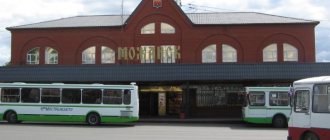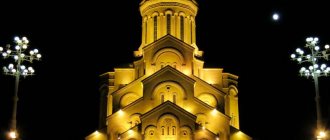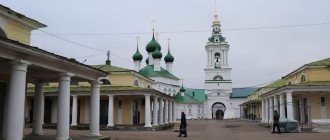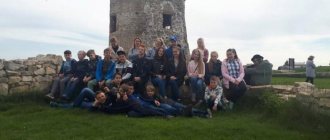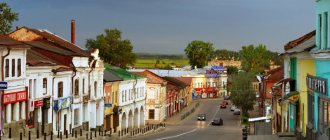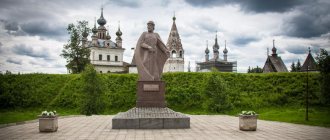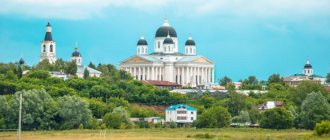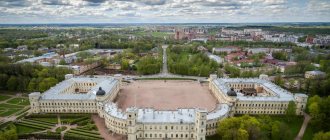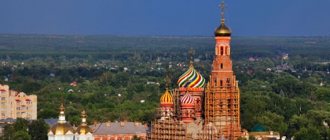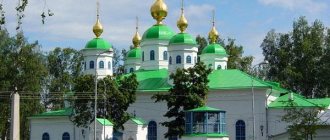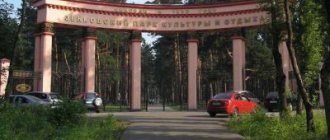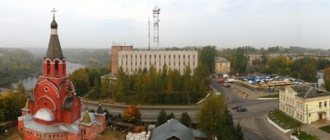Gatchina has two faces. Most people know this city in the Leningrad region thanks to the popular excursion to the Gatchina Palace and Park, as well as the Priory Palace. I also became acquainted with Gatchina thanks to the palace, but one day I decided to return and saw the other side of the city - cozy streets, wooden houses, beautiful cathedrals and even an unusual estate in the style of northern modernism. We walked all day, so I want to show photos of the sights.
City of Gatchina
We arrived in Gatchina in the evening and checked into the hotel of the same name.
Prices and reviews for hotels in Gatchina
Prices at the Gatchina Hotel
Where is Gatchina
A small and cozy city, mentioned in 1500 in Novgorod documents as the village of Khotchino, changed its state affiliation, owners and name more than once during its existence.
Modern Gatchina is located in the southwest of the Leningrad region, not far from St. Petersburg. They are separated by a distance of 42 km, but are connected by a well-established transport network. To the city with coordinates 59°34′ N. w. 30°08′ E. You can get there from the northern capital by electric train, bus or car.
By rail
An electric train departs hourly from the Baltiysky railway station (Baltiyskaya metro station) towards Gatchina. If its final destination is the Gatchina-Baltiyskaya station, then you should get off there. Travel time is 1 hour 10 minutes, fare is 102 rubles.
Then walk to the Gatchina Palace and Park, the vast territory of which is surrounded by a forged fence and has several entrances. The nearest one is 500 m along Cuirassier Boulevard.
The stop of any transit train heading to Luga, Slantsy and so on will be called “Tatyanino”. In this case, you will have to walk along Sobornaya Street to the nearest entrance 1.5 km.
Gatchina, the sights of which you can start exploring on your own from Prioratsky Park, has on its territory another station, next after Tatyanino, Gatchina-Varshavskaya. From it to the entrance gate - 200 m along Chkalova Street.
By bus or minibus
Transport departs from the station. m. "Moskovskaya" St. Petersburg. Bus N 431 runs to Gatchina at intervals of 45-50 minutes. and minibuses NN K-18 and K-18a with breaks of 20 minutes. Travel time - 50 minutes, ticket price - 70-80 rubles.
Minibus K-18a goes all the way to the Gatchina Palace; K-18 and the bus will be taken to Sobornaya Street, which you will need to walk along; bus stop on the street Leonova will give you the opportunity to start the tour from the Priory Ensemble.
By car
St. Petersburg and Gatchina are connected by the Kiev Highway. The distance from the ring road to the city is only 30 km. Free parking is available next to the palace complex.
Museum of the History of Aviation Engine Building and Repair
Address: st. Grigorina, 7a Phone: (8-81371) 2-54-58 Website: https://www.museum.ru/m3031 Opening hours: 11.00-16.00 on Friday, Saturday and Sunday. Pre-arrangement required Cost: free
The museum is located on the territory of the 218 aircraft repair plant (opposite the Gatchina Palace) and occupies an area of 800 square meters. meters.
The main exhibits of the museum are full-scale models of turbojet, aviation, turboprop, turboshaft engines, made according to the prototype of real ones, decommissioned by some design bureau. Next to the engines are small models of the aircraft on which they were once installed.
In addition to models, in the museum you can learn the history of aircraft, interesting facts about aircraft and engine designers, and the repair plant itself.
Weather, best time to visit
The climate in the region is temperate continental, its formation is influenced by the air masses of the Atlantic Ocean and the Baltic Sea. Therefore, mild winters with thaws and warm, sometimes even cool summers are typical for Gatchina. The city is located in an area of high humidity, with annual precipitation exceeding 700 mm.
Daytime air temperature (0C), amount of precipitation (mm) and sunny days:
| Jan. | Feb. | March | Apr. | May | June | July | Aug. | Sep. | Oct. | Nov. | Dec. |
| -5,5 | -4 | 0 | +7,5 | +16 | +19 | +23 | +21 | +15 | +7 | +2 | -2,5 |
| 26 | 25 | 19 | 27 | 24 | 34 | 43 | 44 | 28 | 33 | 30 | 29 |
| 1 | 1 | 2 | 7 | 18 | 15 | 15 | 19 | 10 | 6 | 3 | 1 |
The tourist season in Gatchina lasts all year round, but the most comfortable time to visit the city is from May to September.
Religious buildings
Today more than 90 thousand people live in Gatchina. In terms of national composition, the majority are Russian; in terms of religion, Orthodoxy predominates.
Church of the Most Holy Life-Giving Trinity
The house church of the Gatchina Palace was built under Count Orlov simultaneously with the main building (second half of the 18th century) and by the same architect (Antonio Rinaldi). After the death of the count, the palace belonged in turn to the ruling members of the royal family or the great princes, and the temple was used by them for its intended purpose: prayer services were held here, sacraments were performed, and shrines were kept.
The house church was rebuilt many times. The last time the court architect R.I. was involved in designing its interior was in the mid-19th century. Kuzmin, on the instructions of Nicholas I. He decorated the prayer hall in the style of the Italian Renaissance: windows with arched ends, columns, openwork grilles.
After the revolutionary events, the church was closed, remained in disrepair and was revived again in 1999. The uniqueness of the temple is that, having survived difficult times, it did not perish. Restorers managed to restore the original decor of the mid-19th century.
The oldest temple in the city is a functioning Orthodox Church (services are held on Saturdays) and a valuable architectural monument. It is located at: Krasnoarmeysky Prospekt, 1.
Cathedral of St. Paul the Apostle
The main city cathedral, built in the 19th century according to the design of the architect R.I. Kuzmin, is located at Sobornaya Street, 26. The city needed a cathedral.
The installation location on a hill was determined by the emperor himself; the temple was supposed to float above the city. Nicholas I erected the five-domed cathedral in memory of his father; experiencing remorse over the death of his parent, the tsar ordered the building to be decorated in severity and grandeur, without excessive luxury and gilding.
Pavlovsk Cathedral was closed only once for a short period of time, just before the war; the rest of the time it performed all religious rites and received believers even during the occupation.
True, its strategic position was used by both armies to adjust fire, conduct observations and install machine gun crews. After the war, the building was restored, and the city’s temple has continued its activities for more than 165 years.
Intercession Cathedral
The largest temple in the Leningrad region, consecrated in honor of the Mother of God, was built at the beginning of the 20th century. It is located at: st. Krasnaya, 1a and is a cultural monument.
A beautiful white stone building with blue domes can be seen from afar; it is stately and elegant. The interior is bright, filled with glare from the stained glass windows. The cathedral is open daily, services are held as scheduled, and visitors are allowed to take photos and videos.
Intercession Cathedral (Church of the Intercession of the Blessed Virgin Mary)
Address: st. Krasnaya, 1. Phone: +7 (81371) 9-47-98 Website: https://pokrov-gatchina.ru Opening hours: services in the temple are held daily: at 9.00 and 16.30, there is an educational center and an Orthodox Youth Club.
The Gatchina merchant Kozma Karpov invested 90 thousand rubles in its construction in 1895. Fr. advised him to manage his money so wisely in his declining years. John of Kronstadt (priest and preacher, later elevated to sainthood). The missing 6 thousand rubles were donated by local residents and soon the red brick walls were crowned with blue domes.
The merchant also donated the icon of the Protection of the Most Holy Theotokos, in whose honor the main chapel of the temple was consecrated. There are several chapels in the cathedral: in the name of Nicholas the Wonderworker, Alexander Nevsky, John of Kronstadt. All of them are richly decorated with icons.
Those who came to Gatchina a few years ago remember the bright red brickwork of the Intercession Cathedral. Today the temple is almost completely plastered, but it is still crowned with the same large blue domes.
The most interesting museums
The city has museums that may be of interest to lovers of history, technology, and art.
Museum-Estate of P. E. Shcherbov
One of the oldest museums in the region was opened in 1967. Previously it was located in the Priory Palace, and in 1992 it moved to the restored estate of the cartoonist P.E. Shcherbov, famous at the beginning of the 20th century. It receives 14 thousand visitors a year and has a collection of 16 thousand items.
The museum's exposition is currently displayed on 2 floors, on an area of 200 sq. m:
- 1st floor – a collection telling about the life and work of the former owner of the estate and his friends;
- 2nd floor - the history of Gatchina, the development of aviation and the war years.
The artist’s house is also a museum exhibit, differs from the buildings of St. Petersburg in the Art Nouveau style, and stands out for the boldness of the techniques used by the architect.
The museum is open daily from 10 to 17. Closed on Monday. The cost of an adult ticket is 100 rubles. There are benefits.
Don't miss the most popular article in the section: The best ski resorts in Azerbaijan.
Museum of the City of Gatchina
In 2009, the city museum, created on the initiative of veterans, opened its doors at the address: 25 Oktyabrya Ave., 18. The permanent exhibition tells about the life of the region in pre-Petrine times, about the development of Gatchina during the reign of Paul I, and about the events of subsequent centuries.
There are excursions on the works of local artists, scientific inventions, and famous fellow countrymen of Gatchina. The museum owns 14 thousand storage units and conducts educational and scientific work.
Museum "Nanny House of A. S. Pushkin"
Address: Leningrad region, Gatchina district, Kobrino village, 27 Telephone: (813-71) 58-510 Website: https://www.museum.ru/M270 Opening hours: from 10.00 to 16.00, except Monday, Tuesday Cost : Without excursion: adults – 50 rubles, schoolchildren – 30 rubles. With excursion: adults – 130 rubles, schoolchildren – 70 rubles. How to get there: from Warsaw railway station in Gatchina by bus No. 534, No. 151.
The only museum in the world created in memory of a serf woman is located in a wooden house with more than 200 years of history. During the restoration, only the roof and floor were replaced.
All museum exhibits, which give an idea of what a peasant hut of the 18th century looked like, were donated by Kobrin residents and admirers of Pushkin. Here you can see a rolling pin and a ruble, spinning wheels, icons, and a hanging cradle. There is only one relic - a bag-bag made of homespun fabric, belonging to Pushkin's nanny. Opposite the museum there is a café called Nanny's.
Monuments and Monuments
Gatchina (you can see the sights on your own just by walking along the city streets) is decorated with both modern sculptures and works of famous masters of historical and artistic value.
Monument to Paul I
The work of the famous court sculptor I.P. Vitali is installed on the square in front of the Gatchina Palace. The founder of the city stands on a high granite pedestal, leaning on a cane and looking complacently into the distance.
To recreate the image of the emperor, the sculptor turned to a lifetime painting painted in 1796 by the court artist Shchukin. The order for the monument was made by Nicholas I in memory of his father. It was installed in Gatchina in 1851.
A second similar monument stands in Pavlovsk, where the emperor, standing on a granite pedestal, receives his guests arriving along Lipovaya Alley.
Monument to the defenders and liberators of Gatchina
The city, which was under occupation during the war, gratefully remembers the feat of the heroic defenders and liberators of Gatchina who laid down their lives here. The monument was opened in 1995 in Revolutionary Lane. The authors of the granite monument are V.V. and Yu.F. Shevchenko.
The image of a soldier in a helmet, with a weapon in his hands, is drawn from a block of stone. At its foot was laid a capsule with a message to descendants, which should be opened in 2045.
Monument to the Farman aircraft
The first Russian military airfield appeared in Gatchina in 1910. 100 years later, in the city, on Cuirassier Boulevard, next to the aircraft engine plant, a monument to the Farman aircraft, which was once based at the local airfield, was erected.
At the beginning of the 20th century, aviation was considered the sport of aristocrats; The airport, which appeared in an aristocratic suburb of the capital, owned 10 aircraft, workshops, a gas storage facility and a weather station. The first flight “St. Petersburg – Gatchina” was carried out on a Farman aircraft.
Religious sites
Gatchina was honored with a mention in the calendar of the Russian Orthodox Church - October 25 is marked by the celebration of the Transfer of part of the Holy Cross to Gatchina. The Knights of the Order of Malta presented this relic to Paul I in 1800.
Among the city's iconic religious attractions are:
- The Church of All Saints is an Orthodox church in pseudo-Russian style, erected in 1889 on the site of a cemetery chapel. During the Soviet years it was closed, suffered serious damage during the war of 1941–1945 and was not restored. Since 2014, it has been an active church, despite its extremely dilapidated condition. The church is located in the city cemetery on the street. Solodukhin. Opening hours: Monday, Wednesday and Friday: 12.00–16.00, Saturday, Sunday: 9.00–16.00;
- St. Nicholas Church is a Lutheran (Protestant) church built in 1825–1828. The stone building with a 4-column portico belongs to the classicism style. In 1938, the parish and the church were closed, then, during the war year, the building itself was destroyed. Since 1995, it has been a newly functioning Lutheran church, which can be visited at the address: 25 Oktyabrya Ave., 39. Opening hours: Tuesday, Thursday, Sunday: 10.00 – 13.00;
- Cathedral of St. Apostle Paul - a church built in 1852 in the Russian-Byzantine style. Nicholas I himself chose the place and ordered the foundation of a church in honor of his father, Emperor Paul. Despite attempts at reconstruction during the Soviet era, the appearance of the cathedral has remained unchanged to this day. The stone building is crowned with 5 ungilded domes - a large central one and four small ones. For believers, the cathedral will be of interest for its icon paintings, shrines and relics. The current temple on the street. The cathedral is open from 8.30 to 20.00.
Architectural structures
The city has preserved buildings that are classified as architectural monuments and specially protected objects. But the royal residences are of greatest interest to tourists: the Gatchina and Priory palaces.
Gatchina Palace
Gatchina begins for tourists who come to explore the city on their own or as part of an excursion group, with the main attraction - the Gatchina palace complex. Its emergence is associated with the reign of the Great Empress Catherine, who gifted her favorite with land.
Count Orlov launched serious construction, and 15 years later, upon completion of large-scale work, in 1781 a rare beautiful palace by the Italian architect Antonio Rinaldi and a unique landscape park, masterfully integrated into the natural terrain with spring lakes, rivers and canals, appeared here.
The Gatchina Palace is the main attraction, which will take a whole day to explore on your own.
The central location is occupied by a three-story building, topped by high towers and connected to lower wings by arched wings. The outbuildings were used as service premises and had courtyards for convenience.
The interiors of the palace, as described by contemporaries, were magnificent. But Count Orlov did not own this treasure for long; after his death, Catherine the Great bought the palace. The building was slightly altered, and from 1783 it became the royal residence in Gatchina.
In 1796, Paul I became the emperor of the country, who practically moved to Gatchina, turning the palace into a fortress with bastions, a moat, and powerful guards. The years of his reign saw the powerful development of the city: the nobility, trying to be closer to the king, built houses, institutions, entertainment and other establishments here.
After the assassination of Paul I, subsequent rulers, maintaining the palace in proper condition, came to the city infrequently.
After 1917, a museum was opened in the Gatchina Palace to familiarize people with the life of the kings. Large-scale reconstruction of the building began in 1976 and is still underway. The museum does not stop its work for a single day, immediately opening the doors to the restored premises.
Today visitors can see:
- on the ground floor there are rooms of Paul I with personal belongings, his portraits by famous artists, a collection of paintings;
- on the second floor there is a suite of magnificent halls, including the dining room, the boudoir of Empress Maria Feodorovna, and the ceremonial bedchamber, as well as a collection of weapons of Russian emperors;
- third floor - an exhibition about the history of the palace museum, an art gallery and a functioning house church.
In addition, the palace is open after reconstruction:
- underground passage built under Count Orlov;
- signal tower (one of two towering above the central building), on which there is an observation deck;
- Arsenal Hall
The museum is open from 11 a.m. to 7 p.m., seven days a week. The cost of an adult ticket is 400 rubles, for children and pensioners – 200 rubles.
Priory Palace
The building, built in 1799 on the instructions of Paul I, was donated by him to the Order of St. John of Jerusalem. But it was never used for its intended purpose, remaining a spare palace.
The Priory Palace is considered a symbol of Gatchina; it is easily recognizable due to its unusual architecture. Built near the Black Lake, it looks like a fortress in the Gothic style.
The author of the palace is architect N.A. Lvov, which used an innovation during construction: the material was ordinary earth, manually compressed in special formwork.
The second name of the castle is “earthen”. The author erected the structure as “temporary”, giving it a period of no more than 50 years. The palace still stands, more than 200 years old, and is a decoration of the city and a museum with an exhibition about its history. The museum is open in summer from 11 to 19, in winter from 10 to 18. Ticket price – 200 rubles, discount – 100 rubles.
Interesting and unusual places
Gatchina (the city's attractions are extremely numerous) will also delight those who like extraordinary architectural solutions.
Among the very unexpected objects it should be noted:
- The Birch House and the “Mask” portal are the so-called “garden trompe l’oeil” located in the Palace Park. There are two surprises for the eyes here: a classical portal with columns hides a house reminiscent of a woodpile. And the outwardly shepherd's house itself surprises guests with an interior with mirrors, exquisite furniture and paintings. The house burned down during the war and was restored only in 1975; today it is open to visitors only in the summer. Paid entrance;
- “Echo” grotto and underground passage - an arched underground passage created in the 1770s by order of Count Orlov with a facade designed by Rinaldi. The tunnel owes its name to its unusual acoustics - words spoken at certain points are echoed 20-30 times. An underground passage connects the pier on the shore of Silver Lake with the basement of the Grand Palace;
- cold bath (summer bath) - a structure typical of landscape parks of that time, located not far from the Eagle Pavilion. By the end of the 18th century, the stone-lined pool was ready, it was planned to erect a stone building over it, and install a stove or fireplace inside. However, the building was not completed, and only the swimming pool has survived to this day, where visitors to the park enjoy swimming in the hot summer;
- Karpin Bridge - designed to connect the artificial slopes separating White Lake and Karpin Pond (a man-made reservoir shaped like a jug). The bridge not only complements the appearance of the Grand Palace and looks impressive when reflected in the water, it is also an excellent platform for viewing the surrounding landscapes and structures. During the war, the bridge was destroyed; restoration was carried out in the 80s of the 20th century;
- The Palace Farm pavilion is also one of the traditional park buildings, and now it is an unusual attraction on the banks of the Kolpanka River in Sylvia Park. In the 18th century, the farm supplied fresh milk and butter to the palace. The farm is currently being restored, and the pavilion is open to the public in the summer. Paid entrance.
Natural attractions
Gatchina is located in a picturesque place among forests, fields, rivers and lakes. The city streets are decorated with parks and squares. But the small city has two luxurious palace parks on its territory.
Gatchina Park
Simultaneously with the construction of the Gatchina Palace, an English landscape park with alleys, pavilions, ponds and bridges was laid out. The masters, using the entire arsenal available to them, managed to create a magnificent European oasis in the northern region, which is still considered one of the best in the suburbs of St. Petersburg.
It is surprising that the park was carefully preserved after the revolution in Russia, and during the occupation of Gatchina by the Nazis, and during the years of perestroika.
Now, as in the palace, a successive large-scale restoration of its territory is underway; a lot has already been done, but there is still a lot of work ahead.
During the walk, visitors will see:
- monument to Paul I on the parade ground in front of the palace;
- Jordan Porch;
- Own garden;
- Palace Gardens;
- Karpin Bridge over the pond of the same name;
- Chesme obelisk;
- farm
- Pavilion of Venus and much, much more.
Visiting the park is free. Opening hours from 6 to 22 hours.
Priory Park
During the reign of Paul I, construction of another palace park began. Work began with the improvement of the Black Lake, on the shore of which the Priory Palace was built.
The lake was cleared, deepened, and given greater relief. The earth was dumped from the bottom nearby, creating hills and artificial islands. The landscape park was so good that subsequent rulers supported its “flourishing state” in every possible way, prohibiting any construction on its territory. The entrance here was open to citizens. Today the park is not a museum; cottages have begun to be built on its territory.
Parks and squares
Despite the splendor of the palaces, Gatchina parks are no less famous. Here landscape masterpieces were created in the best traditions of that time - with artificial ponds, pavilions, bridges and trimmed trees - the Russian emperors sought to follow the European park fashion.
Most of the city center is occupied by parks, including:
- Silvia Park was once part of the Palace, now it is an independent territory, separated from the park of the Grand Palace by the Silvia Gate and bordering Krasnoarmeysky Avenue. The architect Brenna and the garden master Hecquet worked on the creation of the park in 1792–1800. The name "Sylvia" comes from the Latin "forest". In addition to forest landscapes with the Kolpanka River, here you can see the Farm, Poultry House, and Black Gate. The composition of the park is based on strict geometry with three radial rays and alleys intersecting them. Entrance to the park is free;
- Palace Park - the oldest park in the city with a stepped layout was created in the 1770s, and until 1880 the arrangement was carried out by Count Orlov, and then the work was carried out by order of Paul I. The arrangement of alleys and the installation of park structures was carried out in accordance with the natural landscape and local reservoirs. The park contains pavilions, dedicated gardens, bridges, water and forest labyrinths. Entrance to the park is free, with the exception of pavilions;
- The Menagerie is a landscape park complex adjacent to Sylvia and Palace Park on the north side. In the 18th century, animals intended for imperial hunting were kept here. After Gatchina passed to Paul I, alleys were laid here, new trees were planted, bridges were built, and even an artificial lake was created. Free admission.
Priory Park is part of the city palace ensemble, not part of the museum-reserve. The park (this area was once called the Small Menagerie) is located south of Dvortsovoye and is occupied by forest plantations. There is only one large building on its territory – the palace of the same name.
Interesting places to relax with children
A vacation program with a child in Gatchina will differ little from a visit to the city by adults.
First of all, these are palace and park ensembles. To interest a child, you need to prepare for the excursion and tell him the history of the Russian tsars in a language accessible to him. You can take a scooter or bicycle to the park, periodically arrange “breaks” with ice cream or have a thorough rest in a cafe.
The Gatchina Museum organizes a special excursion “Museum Chests” for children, but you need to check the time of the excursion.
The Gatchina Youth Theater has a good repertoire, its performances will also be interesting for adults. Schoolchildren should visit the Museum of Aviation Engine Engineering, where they will talk about the role of Gatchina in the development of domestic aviation.
Route to explore on your own
Gatchina (you can explore the sights on your own by making a pre-planned visit) offers tourists an extensive cultural program. An approximate route could be:
1 day:
- Visit to the Great Gatchina Palace.
- After lunch, a walk through Gatchina Park.
- In the evening you can go to the theater-studio “Around the Corner”.
Day 2:
- Visit to the Priory Palace and park.
- Intercession Cathedral.
- After lunch – the museum of the city of Gatchina.
Day 3:
- Museum-Estate of P. E. Shcherbov
- Cathedral of St. Pavel
- Walk around the city with inspection of the Ingerburg Gate, the Constable, and monuments.
Gatchina operating hours
Gatchina Park is beautiful because entry to it is free. You can walk here every day from 06.00 to 22.00. If you plan to visit the Gatchina or Priory palaces, then there is a separate schedule for them. Gatchina Palace (castle) is open daily, except Mondays, from 11.00 to 19.00 (the ticket office is open until 18.00); The Priory Palace is open every day, except Mondays and Tuesdays, from 11.00 to 19.00 (the ticket office is open until 18.00).
The entrance ticket to the Gatchina Palace (castle) is 450 rubles, to the Priory Palace - 200 rubles. You can buy a single ticket for 600 rubles. Also in the summer, organized outdoor excursions are held in the park; the cost of such excursions is 350 rubles per person. Tours are conducted by session.
Ninara/Grand Gatchina Palace, apartments
Hotels
The city provides guests with the opportunity to choose a place to stay based on their tastes, desires and capabilities. In modern Gatchina there are hotels, private inns, and hostels.
Hotel Gatchina
The building is located on the street. Gorky, 21, not far from the Priory Palace. The hotel has a shared lounge, luggage storage, parking, free internet.
Rooms with a private bathroom are equipped with necessary furniture, household appliances and hygiene products. The price includes breakfast. Price – from 3300 rub.
Hotel Priorat
Hotel on the street Chkalova, 59a is located in the historical center of the city, 1 km from the Gatchina Palace. It offers 1-3 bed rooms with all amenities, air conditioning, refrigerators, cable TV. Near the hotel there are city attractions, cafes and shops. Cost – from 1600 rubles.
Hotel Aksioma
Visitors are offered rooms with all amenities, television, refrigerators. But those who wish can also stay in a capsule room with a shared bathroom and toilet. Cost – from 800 rub.
What to bring from Gatchina
The city administration encourages the production of souvenirs - there are even competitions for the best sketches of commemorative items. Therefore, in stores you can find original ceramics, tapestries, and nesting dolls.
As a souvenir or as a gift, it makes sense to purchase:
- magnets and postcards - as in any “tourist” city;
- books, calendars, guidebooks;
- watches or paintings with local landscapes;
- shawls and scarves with picturesque paintings;
- porcelain and silver produced by a local factory;
- tapestries;
- chocolate factory Krupskaya.
In order to see all the sights of the city, even a few days are not enough, but to look at Gatchina as an imperial residence with palaces and parks, one day is enough.
And if you stay a couple more days, you can see local museums, temples, unusual monuments, and just the streets of the historical center of the city.
Article design: Svetlana Ovsyanikova
Where to eat
There are establishments in the city where it is convenient to relax and eat along the route, making this or that excursion.
Cafe "Pyramid" is located at: st. Sobornaya, 3. An old-timer of Gatchina catering is located on the way to the Priory complex. According to visitors' reviews, pizza and pasta are prepared well here. The average bill is 700 rubles.
Cafe "Ginger" offers dishes of European, Russian and Georgian cuisine. There is a children's menu, animator services, and play sets. Open from 10 a.m. to 11 p.m., on weekends until 2 a.m. Located on 25 Oktyabrya Avenue, 42. The average bill is 700-1500 rubles.
Where to go for a tourist in Gatchina: interesting places
Where can a traveler go for fun in a small town? You won't be bored. Although there are few entertainment and places for shopping in the city, there is always something for a tourist to see in Gatchina.
Park "Zverinets"
Created 250 years ago, the object was home to many animals: bears, wolves, fallow deer, deer, wild boars, birds. Thousands of linden trees decorated the park, and an artificial lake was crossed by bridges, connecting it with islands of greenery. Now these memorable places are visited by tourists with pleasure for walking and studying picturesque examples of landscape art of past centuries.
Location: st. Red Road, 1.
Opening hours: daily, 6.00-22.00.
You can get there by buses 8, 29 to the Internat stop.
Get directions
Shopping center "Megapolis"
The shopping and entertainment center is considered the best class “A” trading platform in the Leningrad region and the center of trade in Gatchina. The superstore area covers 10,000 square meters. m. In addition to clothing boutiques and hardware stores, there are jewelry stores, pharmacies, agencies, and places where you should go with your family: food courts, a cinema, and gaming entertainment for adults and children.
Address: 25 October Avenue, 42.
Opening hours: every day, 11.00-19.00.
Travel by bus 21 to the “Vezd” stop.
Get directions
Crafts stall
The only artisan shop in the Leningrad region. They do not sell Chinese counterfeits. Everything that is sold here is handmade by Russian craftsmen: from artists to blacksmiths. Tourists can buy gifts and souvenirs for their souls and friends. The range is impressive.
Address: Krasnoarmeysky prospect, 1.
Opening hours: every day, 11.00-18.00.
Travel by buses 3, 7, 518 to the Gatchina Palace stop.
Get directions
Restaurant "Ingerburgsky"
A rare restaurant that has its own brewery and zoo. The fish in the pond are calming and create a pleasant atmosphere. The menu consists of German dishes. Beer in bottles with branded labels can be taken with you. Guests of the establishment assure that it is excellent here.
Address: 7th Army Street, 22.
Opening hours: daily, 11.00-01.00.
Travel by bus 22 to the Sobornaya stop.
Get directions
Musical buffet SOUL
The symbiosis of culture and delicious farm food is a real oasis of pleasant relaxation. The barista will brew aromatic freshly roasted coffee, and the performance of musicians will awaken the soul. Jazz, soul, funk are listened to here only on vinyl!
Address: Pushkinskoe highway, 13 building 3.
Opening hours: daily, 09.00-23.00.
Travel by bus 27 to the Ingerburg Gate stop.
Get directions
Family entertaining
Large park for family active recreation. Area 700 sq. m contains a labyrinth, a jumping pit, a climbing wall, a tubing slide, trampolines, carousels, air hockey, air cannons and slides. There will be entertainment for both adults and children. Experienced animators work for free.
Address: Pushkinskoe highway, 15.
Opening hours: daily, 10.00-21:00.
Travel by bus 21 to the Cubus shopping center stop.
Get directions
Artist's shop
The store-gallery sells works by local artists. The colorful landscapes of Gatchina and portraits of famous historical figures are purchased by most tourists. Here you can buy art supplies and souvenirs at an affordable price.
Address: Chkalova street, 79.
Opening hours: every day, 10.00-19.00.
You can get there by bus 21 to the Musical School stop.
Get directions
City Museum
The museum has collected exhibits telling about the formation of the city from the pre-Petrine era to modern times. The halls contain the most interesting household items, clothing, mechanisms and equipment of those times. Museum guides conduct walking tours of the historical places of Gatchina.
Address: 25 October Avenue, 18.
Opening hours: daily, except Tuesdays, 10.00-18.00.
You can get there by buses 3, 4, 7, 8, 22 to the Spartak Stadium stop.
Get directions
Estate-Museum of P. Shcherbov
The old museum is located in the two-hundred-year-old estate of the artist Shcherbov himself, built by the famous architect Krichinsky in the spirit of northern modernism. The original building with its turret and portals is completely asymmetrical, which gives it great originality. The inside of the museum is even more interesting: a stone fireplace, antique furniture, an oak staircase. The walls are crowned with famous works by the original artist.
Address: Chekhov street, 4.
Opening hours: daily, 10.00-17:00.
Travel by bus 7 to the “Lieutenant Schmidt Street” stop.
Get directions
Aviation Engine Museum
The museum is located in a century-old mansion, which was previously owned by the lancers of the Guards Regiment. The exhibition halls spread over 800 square meters. m and display 15 complete copies of aircraft engines. An experienced guide will tell you about the history of aircraft engine construction.
Address: Grigorina street, 7A.
Opening hours: Wednesday-Sunday, 10.00-16.00.
Travel by bus 28, 518 to the Baltic Station stop.
Get directions
Museum "Nanny House of A. S. Pushkin"
A museum created specifically for the sake of a serf woman - nanny A.S. Pushkin. The ancient 300-year-old wooden house has retained the charm of a simple peasant hut. Everything in it remains as it was under Arina Rodionovna: a chopped cradle hanging on rings, a spinning wheel, icons, wooden kitchen utensils and an untouched Russian stove. A camping bag made of hard cloth is a museum relic, a personal item of the poet’s nanny.
Address: Kobrino street, 27.
Opening hours: all days except Tuesday, 10.00-16.00.
You can get there by buses 534, 151, stop “Kobrino”.
Get directions
Theater "Around the Corner"
The theater began as an amateur club 84 years ago. Now “Around the Corner” is a permanent participant in the cultural life of the region. The repertoire is based on world classical works. Children love to watch modern productions: “Pippi Longstocking”, “Aibolit”, etc.
Address: 25 October Avenue, 1.
Opening hours: daily, 13.00-19.45.
Take bus 21 to the Musical School stop.
Get directions
Exhibition “Art Collections of the Gatchina Palace”
The exhibition is housed in 12 spacious halls and is permanent. Valuable works by European masters of the 17th-18th centuries are presented: Giordano, Silvestre, Forte, Courtois Bourguignon. The main attraction of the collection is the painting “Expulsion from Paradise”, painted by Luca Giordano. In addition to paintings, the museum has a rich fund of furniture, dishes, unique books, and porcelain.
Address: Krasnoarmeysky prospect, 1.
Opening hours: daily, 10.00-18.00.
You can get there by bus 543 to the “Palace” stop.
Get directions
Gatchina Museum-Reserve
An unusual museum-reserve - a mixture of the styles of the Hermitage and Hamlet's castle. The palace, part of the ensemble, served as the residence of the royal family and has gone through more than one restoration. The territory includes a garden, a signal tower, buildings for hunting and recreation. These are places worth visiting. Concerts, festivals and costume balls are held in luxurious halls, the hosts of which are the impromptu Paul I and his wife Maria Feodorovna.
Address: Krasnoarmeysky prospect, 1.
Opening hours: daily, 10.00-18.00.
Travel by bus 543 to the “Palace” stop.
Get directions
Every year thousands of foreign and Russian tourists visit Gatchina. Many tourist places can be visited in 1-2 days. Summer and golden autumn are the right time to travel to the historical places of the old city.
How to navigate
Public transport in Gatchina is represented by buses and minibuses, which follow 11 routes. From the city bus station, which is located at the Gatchina-Varshavskaya railway station, buses depart throughout the city and to suburban areas. Several small companies provide taxi services for passengers. Network mobile taxi calls work.
Gatchina is a city that is worthy of a visit to get acquainted with its unique sights. It’s not at all difficult to do this on your own, the historical center is small, and the tourist infrastructure is well developed.
Article design: Vladimir the Great
